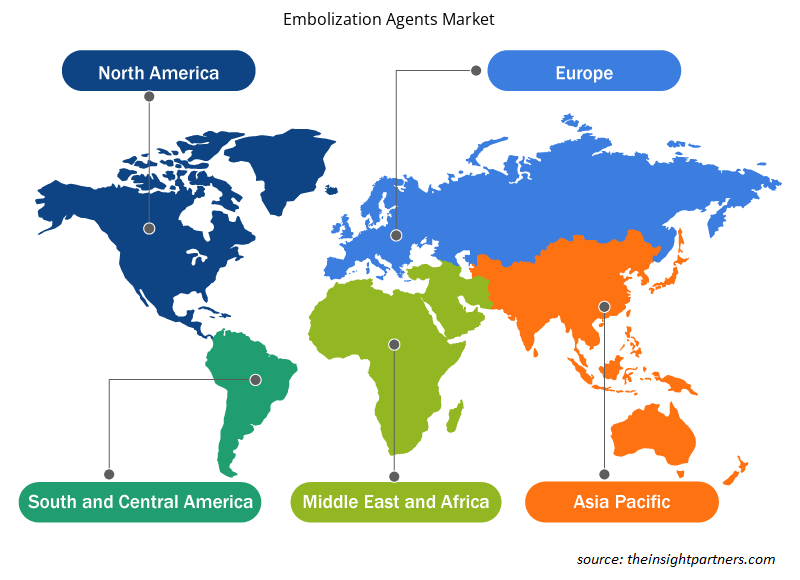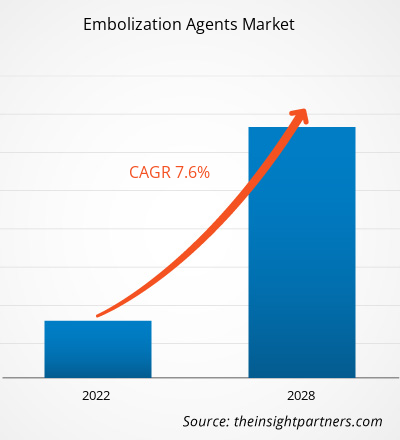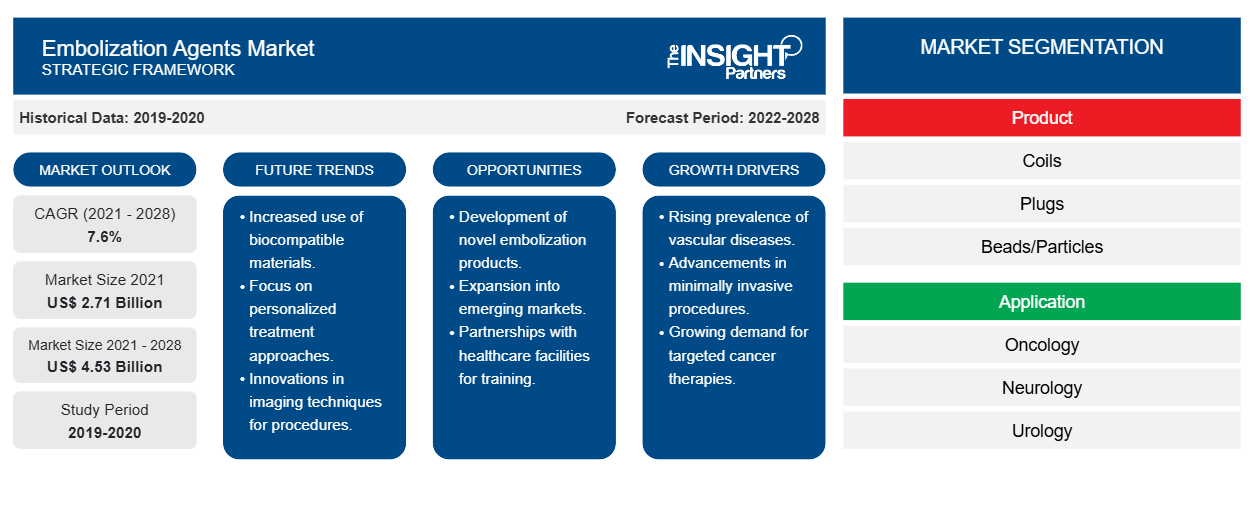Se proyecta que el mercado de agentes de embolización alcance los US$ 4.525,75 millones para 2028 desde los US$ 2.714,82 millones en 2021; se espera que crezca a una CAGR del 7,6% entre 2021 y 2028.CAGR of 7.6% from 2021 to 2028.
El crecimiento del mercado se atribuye a la creciente incidencia de tumores y aneurismas y a la creciente prevalencia de hipertensión, obesidad, tabaquismo y alcoholismo. Sin embargo, los altos costos de los agentes de embolización restringen el crecimiento del mercado de agentes de embolización . Los agentes de embolización se utilizan para aplicar una oclusión mecánica para detener el flujo de sangre en un vaso sanguíneo o área vascular. En radiología intervencionista, la embolización es un procedimiento común. Los procedimientos de embolización se utilizan principalmente para tratar lesiones traumáticas. Los agentes embólicos vienen en una variedad de formas, cada una con su propio conjunto de propiedades y aplicaciones. Dependiendo de la duración requerida para la oclusión arterial, los agentes de embolización se clasifican como temporales o permanentes. En los EE. UU., La demanda de procedimientos de tratamiento de verrugas se ha reducido debido al cambio en el enfoque en el tratamiento de COVID-19. La pandemia de COVID-19 ha estado causando estragos en las cadenas de suministro globales, los mercados de consumo y las economías. Esta situación ha provocado una disminución de los procedimientos cardíacos realizados en varios países de Asia Pacífico. Las medidas implementadas por los gobiernos de todo el mundo han impactado negativamente en el crecimiento del mercado de agentes de embolización.interventional radiology, embolization is a common procedure. Embolization procedures are mostly used to treat traumatic injuries. Embolic agents come in a variety of forms, each with its own set of properties and applications. Depending on the duration required for arterial occlusion, embolization agents are classified as temporary or permanent.
Personalice este informe según sus necesidades
Obtendrá personalización en cualquier informe, sin cargo, incluidas partes de este informe o análisis a nivel de país, paquete de datos de Excel, así como también grandes ofertas y descuentos para empresas emergentes y universidades.
-
Obtenga las principales tendencias clave del mercado de este informe.Esta muestra GRATUITA incluirá análisis de datos, desde tendencias del mercado hasta estimaciones y pronósticos.
Perspectivas de mercado
La creciente incidencia de tumores y aneurismas impulsa el crecimiento del mercado de agentes de embolización
Según el Instituto Nacional del Cáncer, en 2020, hubo 1.806.590 nuevos casos de cáncer y 606.520 muertes debido a la enfermedad en los EE. UU. En 2020, los cánceres de próstata, pulmón y colorrectal representaron el 43% de todos los cánceres diagnosticados en hombres. Los cánceres de mama, pulmón y colorrectal son los tres cánceres más frecuentes diagnosticados en mujeres. Según el informe de Estadísticas y Hechos de la Brain Aneurysm Foundation, en los EE. UU., alrededor de 6,5 millones de personas, es decir, 1 de cada 50 personas, tienen un aneurisma cerebral no roto. También ha mencionado que el 20% del total de personas diagnosticadas con un aneurisma cerebral tienen más de un aneurisma. Además, ha informado que, cada año, alrededor de 30.000 personas en los EE. UU. sufren una rotura de aneurisma cerebral y una rotura de aneurisma cerebral se produce cada 18 minutos. Además, según el NHS, cada año en el Reino Unido, 1 de cada 12.500 personas tiene un aneurisma cerebral roto en Inglaterra. Además, según el informe 'Patogénesis y tratamiento individualizado de los aneurismas intracraneales no rotos' publicado en Deutsches Ärzteblatt International en 2020, alrededor de 2 millones de personas (adultos) en Alemania tienen un aneurisma intracraneal (AI) no roto. Los agentes de embolización se utilizan para detener de forma aguda el flujo en un vaso sanguíneo o territorio vascular mediante oclusión mecánica. Los agentes de embolización, como las microesferas embólicas (perlas), se utilizan para restringir el suministro vascular a los tumores y pueden cargarse con medicamentos quimioterapéuticos, que se eluyen y difunden en el tejido. Los agentes embólicos líquidos se utilizan para prevenir el suministro de sangre al aneurisma o tumor. Por lo tanto, la creciente prevalencia de aneurismas y cánceres está creando una gran demanda de agentes de embolización.
Perspectivas basadas en productos
Según el producto, el mercado de agentes de embolización se segmenta en espirales, perlas/partículas, tapones, globos desprendibles, pegamento, esponja, embolizantes líquidos, esclerosantes, agentes precipitantes y otros. El segmento de perlas/partículas tiene la mayor participación del mercado. Sin embargo, se prevé que el segmento de espirales registre la CAGR más alta durante 2021-2028. La embolización con espiral es un procedimiento basado en catéter que permite la oclusión precisa del flujo sanguíneo anormal en un vaso sanguíneo. El creciente número de cirugías cardíacas está impulsando el crecimiento del mercado de este segmento.
Perspectivas basadas en aplicaciones
Según la aplicación, el mercado de agentes embolizantes se segmenta en neurología, oncología, cardiología, enfermedades vasculares periféricas y otros. El segmento de oncología tiene la mayor participación del mercado y se prevé que registre la CAGR más alta del mercado durante el período de pronóstico.
Información basada en el usuario final
Según el usuario final, el mercado de agentes de embolización se segmenta en hospitales, centros quirúrgicos ambulatorios, centros cardíacos y otros. El segmento de hospitales tiene la mayor participación de mercado y se estima que registrará la CAGR más alta durante el período de pronóstico. El crecimiento del mercado para este segmento se atribuye al creciente número de hospitales en todo el mundo y al número de procedimientos quirúrgicos en rápido crecimiento.
Las empresas que operan en el mercado de agentes de embolización están adoptando la estrategia de innovación de productos para satisfacer las cambiantes demandas de los clientes en todo el mundo, lo que también les permite mantener su marca en el mercado global.
Perspectivas regionales del mercado de agentes de embolización
Los analistas de Insight Partners explicaron en detalle las tendencias y los factores regionales que influyen en el mercado de agentes de embolización durante el período de pronóstico. Esta sección también analiza los segmentos y la geografía del mercado de agentes de embolización en América del Norte, Europa, Asia Pacífico, Oriente Medio y África, y América del Sur y Central.

- Obtenga datos regionales específicos para el mercado de agentes de embolización
Alcance del informe de mercado de agentes de embolización
| Atributo del informe | Detalles |
|---|---|
| Tamaño del mercado en 2021 | US$ 2,71 mil millones |
| Tamaño del mercado en 2028 | US$ 4,53 mil millones |
| CAGR global (2021-2028) | 7,6% |
| Datos históricos | 2019-2020 |
| Período de pronóstico | 2022-2028 |
| Segmentos cubiertos |
Por producto
|
| Regiones y países cubiertos |
América del norte
|
| Líderes del mercado y perfiles de empresas clave |
|
Densidad de actores del mercado: comprensión de su impacto en la dinámica empresarial
El mercado de agentes de embolización está creciendo rápidamente, impulsado por la creciente demanda de los usuarios finales debido a factores como la evolución de las preferencias de los consumidores, los avances tecnológicos y una mayor conciencia de los beneficios del producto. A medida que aumenta la demanda, las empresas amplían sus ofertas, innovan para satisfacer las necesidades de los consumidores y aprovechan las tendencias emergentes, lo que impulsa aún más el crecimiento del mercado.
La densidad de actores del mercado se refiere a la distribución de las empresas o firmas que operan dentro de un mercado o industria en particular. Indica cuántos competidores (actores del mercado) están presentes en un espacio de mercado determinado en relación con su tamaño o valor total de mercado.
Las principales empresas que operan en el mercado de agentes de embolización son:
- Medtronic
- Corporación Terumo
- Cook Medical LLC
- Corporación científica de Boston
- Abad
Descargo de responsabilidad : Las empresas enumeradas anteriormente no están clasificadas en ningún orden particular.

- Obtenga una descripción general de los principales actores clave del mercado de agentes de embolización
Mercado de agentes de embolización: por producto
-
Bobinas
- Bobinas desmontables
- Bobinas empujables
-
Perlas/Partículas
- Esférico
- No esférico
- Tapones
- Globos desmontables
- Pegamento
- Esponja
- Embolizantes líquidos
- Esclerosantes
- Agentes precipitantes
- Otros
Mercado de agentes de embolización: por aplicación
- Oncología
- Neurología
- Urología
- Cardiología
- Enfermedades vasculares periféricas
- Otros
Mercado de agentes de embolización: por usuario final
- Hospitales
- Centros cardíacos
- Centros de cirugía ambulatoria
- Otros
Mercado de agentes de embolización por geografía
-
América del norte
- A NOSOTROS
- Canadá
- México
-
Europa
- Francia
- Alemania
- Italia
- Reino Unido
- España
- Resto de Europa
-
Asia Pacífico (APAC)
- Porcelana
- India
- Corea del Sur
- Japón
- Australia
- Resto de APAC
-
Oriente Medio y África (MEA)
- Sudáfrica
- Arabia Saudita
- Emiratos Árabes Unidos
- Resto de MEA
-
América del Sur y Central (SCAM)
- Brasil
- Argentina
- Resto de estafa
Perfiles de empresas
- Medtronic
- Corporación Terumo
- Cook Medical LLC
- Corporación científica de Boston
- Abad
- Corporación Stryker
- Penumbra, Inc.
- Sistemas Médicos Merit Inc.
- DePuy Synthes
- CORPORACIÓN KANEKA
- Análisis histórico (2 años), año base, pronóstico (7 años) con CAGR
- Análisis PEST y FODA
- Tamaño del mercado, valor/volumen: global, regional y nacional
- Industria y panorama competitivo
- Conjunto de datos de Excel
Informes recientes
Testimonios
Razón para comprar
- Toma de decisiones informada
- Comprensión de la dinámica del mercado
- Análisis competitivo
- Información sobre clientes
- Pronósticos del mercado
- Mitigación de riesgos
- Planificación estratégica
- Justificación de la inversión
- Identificación de mercados emergentes
- Mejora de las estrategias de marketing
- Impulso de la eficiencia operativa
- Alineación con las tendencias regulatorias























 Obtenga una muestra gratuita para - Mercado de agentes de embolización
Obtenga una muestra gratuita para - Mercado de agentes de embolización